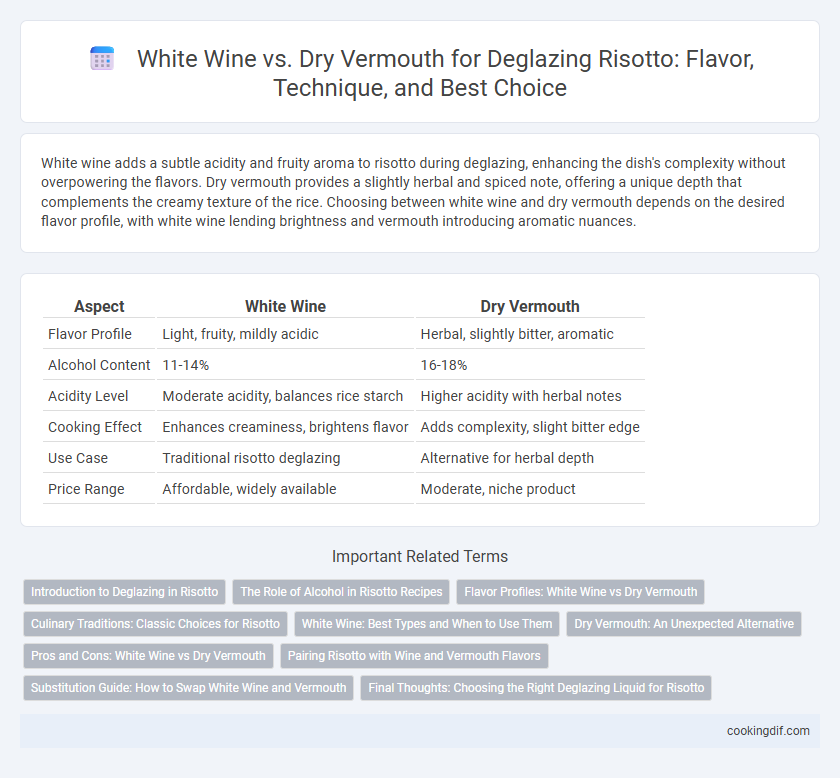White wine adds a subtle acidity and fruity aroma to risotto during deglazing, enhancing the dish's complexity without overpowering the flavors. Dry vermouth provides a slightly herbal and spiced note, offering a unique depth that complements the creamy texture of the rice. Choosing between white wine and dry vermouth depends on the desired flavor profile, with white wine lending brightness and vermouth introducing aromatic nuances.
Table of Comparison
| Aspect | White Wine | Dry Vermouth |
|---|---|---|
| Flavor Profile | Light, fruity, mildly acidic | Herbal, slightly bitter, aromatic |
| Alcohol Content | 11-14% | 16-18% |
| Acidity Level | Moderate acidity, balances rice starch | Higher acidity with herbal notes |
| Cooking Effect | Enhances creaminess, brightens flavor | Adds complexity, slight bitter edge |
| Use Case | Traditional risotto deglazing | Alternative for herbal depth |
| Price Range | Affordable, widely available | Moderate, niche product |
Introduction to Deglazing in Risotto
Deglazing in risotto involves adding a liquid to the hot pan to dissolve browned food residues, enhancing flavor complexity. White wine is traditionally used for its bright acidity and subtle fruity notes that complement the creamy rice texture. Dry vermouth offers a herbaceous, slightly bitter profile with higher alcohol content, which can intensify aromatic layers and deepen the overall taste of the dish.
The Role of Alcohol in Risotto Recipes
The role of alcohol in risotto recipes is to enhance flavors and aid in deglazing the pan, crucial for building the dish's depth. White wine is commonly used due to its acidity and subtle fruity notes, which balance the creamy texture of the rice. Dry vermouth, an aromatic fortified wine, offers a slightly herbal complexity and higher alcohol content, intensifying the risotto's flavor profile while also effectively releasing browned bits from the pan.
Flavor Profiles: White Wine vs Dry Vermouth
White wine offers a bright, fruity acidity with citrus and green apple notes that enhance risotto's creamy texture while maintaining a clean finish. Dry vermouth contributes more complex herbal and slightly bitter flavors from botanicals like wormwood and chamomile, adding depth and subtle spice to the dish. Choosing between white wine and dry vermouth impacts the risotto's flavor profile by balancing freshness versus aromatic intensity.
Culinary Traditions: Classic Choices for Risotto
White wine and dry vermouth each bring distinctive flavors to risotto, aligning with traditional culinary practices. Classic Italian risotto recipes typically favor white wine for its crisp acidity and subtle fruitiness, which enhances the dish's delicate flavors. Dry vermouth, with its herbal and slightly bitter notes, offers a nuanced alternative appreciated in some regional variations, adding depth without overpowering the creamy texture.
White Wine: Best Types and When to Use Them
Dry white wines like Pinot Grigio, Sauvignon Blanc, and Chardonnay offer the ideal acidity and subtle fruitiness for deglazing risotto, enhancing the dish's creamy texture without overpowering its delicate flavors. Use a crisp, unoaked Chardonnay or Sauvignon Blanc when aiming for a bright, zesty finish, while richer, buttery Chardonnays add a rounder, more complex depth. Avoid overly sweet or heavily oaked wines to maintain the classic balance and prevent introducing off-flavors during the deglazing process.
Dry Vermouth: An Unexpected Alternative
Dry vermouth offers a unique herbal complexity and subtle bitterness that enhances risotto's flavor profile during deglazing, creating a more layered taste compared to the fruitier notes of white wine. Its higher alcohol content aids in extracting deeper flavors from the sauteed ingredients, contributing to a rich and aromatic base. Using dry vermouth as an alternative to white wine can elevate traditional risotto recipes by introducing nuanced botanicals that complement the creamy texture.
Pros and Cons: White Wine vs Dry Vermouth
White wine adds a bright acidity and fruity notes to risotto, enhancing the dish's flavor complexity while offering natural sugars that balance savory ingredients; however, its alcohol content can sometimes overpower delicate flavors if not properly reduced. Dry vermouth provides herbal and slightly bitter undertones, contributing a unique aromatic depth and a lower alcohol percentage, making it a subtler deglazing option, though its fortified nature may alter traditional risotto taste profiles. Choosing between white wine and dry vermouth depends on desired flavor intensity and aroma complexity, as well as personal preference for a more classic or innovative risotto.
Pairing Risotto with Wine and Vermouth Flavors
White wine brings crisp acidity and subtle fruitiness to risotto, enhancing the creamy texture and balancing richness with bright citrus and green apple notes. Dry vermouth adds complex herbal and botanical flavors, infusing risotto with aromatic depth and a slightly bittersweet character that complements earthier ingredients like mushrooms. Pairing risotto with white wine emphasizes freshness and lightness, while dry vermouth introduces layered complexity, making each choice ideal depending on the desired flavor profile.
Substitution Guide: How to Swap White Wine and Vermouth
White wine and dry vermouth both offer acidity and depth for deglazing risotto, but vermouth provides a slightly sweeter, herbaceous note compared to the crisp, fruity profile of white wine. When substituting, use equal amounts of dry vermouth for white wine, keeping in mind vermouth's higher sugar content may require slight adjustments in seasoning. For non-alcoholic alternatives, white grape juice with a splash of vinegar or lemon juice replicates the acidity while maintaining the risotto's balanced flavor profile.
Final Thoughts: Choosing the Right Deglazing Liquid for Risotto
White wine enhances risotto with a bright acidity and subtle fruitiness that balances the creamy texture, making it a traditional favorite for authentic Italian flavors. Dry vermouth offers a complex herbal and slightly bitter profile that adds depth and aromatic layers, ideal for a unique twist on classic recipes. Selecting the right deglazing liquid depends on desired flavor intensity and complexity, with white wine providing a cleaner finish while dry vermouth introduces nuanced herbal notes.
White wine vs dry vermouth for deglazing Infographic

 cookingdif.com
cookingdif.com